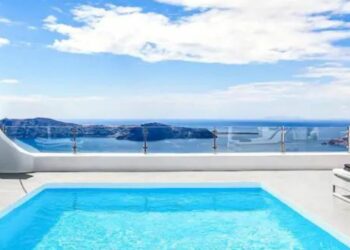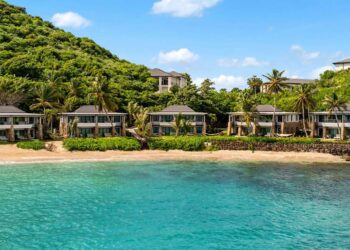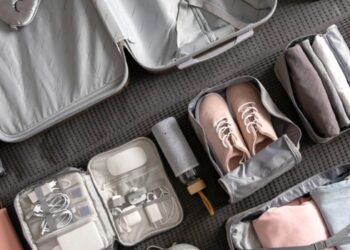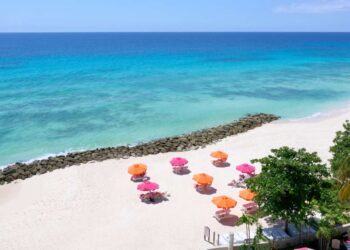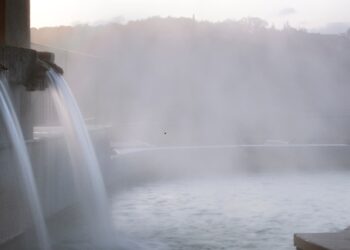For the adventurer, rest assured there’s no limit to what’s possible in South America. Surfing? Skiing? Walking through the Amazon rainforest at night? A visit to the vast Pantanal? Overnight glamping on Bolivia’s salt flats? A crampon-aided walk across a glacier? It’s all there, and the good news is: you can end your active days in luxury.
Argentina: Mount Aconcagua
Most people go to Mendoza, Argentina to sip their way through the area’s famous wineries. But adventure types should also add some extreme skiing at popular Las Lenas, four hours from Mendoza. Then climb Mt. Aconcagua, at 21,463 feet, the second-highest of the Seven Summits, and the highest mountain in the Western Hemisphere. The hiking itself is kind of standard, but the desert air, and freezing cold winds near the summit take stamina. The average length of time to reach the summit is 12 days, and the time to go is December to February.
Insider Tip: You can sign on for a journey that’s a bit more luxe with mules, porters, and a helicopter back down from the base camp on Mountain Madness’s Aconcagua Deluxe.
Where to Stay
One of our favorite hotels in Argentina is the Park Hyatt Mendoza; behind its neoclassical façade are sleek modern rooms. Watch the world go by from the dining terrace, lap it up in the swimming pool, and have easy access to shopping and restaurants. For an authentic Argentine meal, Grill Q is the place. If you do add the wineries to your trip, don’t miss a stay at The Vines Resort & Spa in the Uco Valley, an hour and a half drive south of Mendoza. These spacious modern villas have gorgeous views, but go for the “lakefront” ones, with views across vineyards to the towering Andes. The restaurant is overseen by famed open-fire chef Francis Millman; don’t miss the grilled ravioli.
Patagonia: Torres del Paine and El Calafate
Chile’s Torres del Paine is one of the world’s most breathtaking parks. The peaks of the massif are about as majestic as scenery gets and change color as the day progresses. The sunrises and sunsets will never leave you. There are hikes for all levels including full days on the glacier. With luck, you’ll see pumas (or at least the bones of their prey), condors, bands of guanaco, foxes, and this being Patagonia, herds of sheep.
Insider tip: Go in November for early spring flowers and very few visitors. During the high season, from December to February, crowds can clog the trails.
El Calafate, on the Argentine side, is the gateway to ice trekking on the Perito Moreno glacier, which you can also view by boat, gazing up at the towering 240-foot wall of ice. Aside from occasional dramatic ruptures and the shedding of ice, this glacier continues to replenish. Also accessible from El Calafate are hiking trails through the petrified forest, La Leona, where once dinosaurs roamed and to see the most stunning views of the mountain’s jagged peaks.
Insider Tip: You can also book a four-wheel-drive tour or spend a day horseback riding with the gauchos.
Argentina’s most famous skiing is based out of Bariloche, also in Patagonia.
Where to Stay
You’ll be spoiled for choice by all the lodges in Torres del Paine. Explora is the oldest, with the best variety of hikes. It’s the only one open year-round and the only one actually inside the park, offering crazy beautiful views. Tierra’s dramatic architecture is perfect for design lovers, and Awasi is the place for those who want a bespoke experience, as each guest is assigned a personal guide, who’ll help you plan your days. We also love Eolo Patagonia in El Calafate, set alone on the steppe of a 10,000-acre estancia. Floor-to-ceiling windows and comfortable armchairs allow you to take in the views over the immense, brooding landscape. After a day hiking, ice trekking, or horseback riding, you’ll return to a romantic dinner and plush bedding.
Brazil: The Pantanal
The vast grassy wetlands of the Pantanal clock in at 42 million acres reaching from Bolivia through Brazil into Paraguay. Animal lovers will be thrilled to discover, the area harbors the most jaguars in the world, some 10 million caimans, capybaras, coatis, and the behemoth of parrots, the hyacinth macaw.
Insider Tip: From November to March, the Pantanal is flooded, so the dry July to October months are the best for wildlife sightings.
Where to Stay
The Caiman Ecological Refuge, part of a 70-year-old, 130,000-acre cattle ranch consists of two lodges, located 10 miles apart, each with its own restaurant and pool. The five-suite Cordilheira is the more modern of the two, but we also like the six-suite ranch-style Baiazinha. Both have WiFi and air conditioning, and while neither is exactly five-star, they’re very comfortable, full of character, and the perfect base for exploring.
Colombia: Los Llanos
If just the sound of the “Orinoco River” makes your heart beat faster, these tropical grasslands in Colombia (and Venezuela) are the place for explorers. Los Llanos is home to crocodiles, jaguars, pumas, giant anteaters, giant river otters, Colombian red howler monkeys, the largest freshwater turtles in South America, and pink river dolphins. Ever wanted to see a scarlet ibis? Come here. You can explore by horseback (and during the wet season flooding, that’s the only way) or a 4-wheel drive. Here, the llanero cowboy culture is still very much alive.
Insider Tip: The best time to go is during the dry season from December to April.
Where to Stay
The Corocara Wildlife Camp can send you out on a nighttime search for pumas, then bring you back to experience glamping in one of its four luxury tents, which come complete with four-poster beds, ensuites, and terraces. Forget about WiFi and TV. Instead, the social tent has a bar and dining area, a good selection of music with Bose speakers and a library to help orient you. And with all that beauty, who needs to be connected to the real world. The airport at Yopal is only 30 minutes by helicopter, and there’s radio communication.
Peru: Salkantay Trail
Peru’s Inca Trail to Machu Picchu is world-famous and one of those life-changing experiences, but there’s also an alternative, less crowded, more difficult trail for the adventurous at heart. The Salkantay is generally 43 miles versus the Inca Trail’s 26, depending on the route. You’ll encounter more wildlife, an indelible blue glacier lake, and snow-capped mountains, then descend into the rainforest, and all with only a fraction of the people on the Inca Trail. Yes, you’ll miss arrival via the Sun Gate, but instead, you’ll first see Machu Picchu from the ruins of Llaqtapata, some three miles to the southwest. For a more luxurious experience, it’s possible to hike from lodge to lodge, with porters and mules to carry your gear. Either way, you’ll end the trek in Aguas Calientes, at the foot of Machu Picchu, and you can catch an early morning bus there and beat the crowds. Also worth adding to your Peruvian itinerary, experiencing all the amazing lodges and cruises along the origins of the Amazon River. The intimate luxury ship Aria Amazon from Aqua Expeditions can transport you to the best of the area.
Insider Tip: All the trekking companies suggest acclimatizing a day or two in Cusco (not the Sacred Valley, which is 8,000 feet to Cusco’s 11,000).
Where to Stay
In Cusco, we love the grande dame Monasterio, a Belmond Hotel, where the service is old-school elegant and the former monastery’s furnishings have an air of gravitas. A sun-drenched breakfast in the courtyard is perfect for the weary traveler, and if you’re having trouble with the altitude, there are rooms with oxygen. Next door, its sister Palacio Nazarenas offers more modern, bright interiors and has a pool. We’re also fans of Inkaterra La Casona and Palacio del Inka, a Luxury Collection hotel, and in Aguas Calientes, opt for the mountaintop boutique Belmond Sanctuary Lodge just outside the gate into Machu Picchu, which will put you in the ruins before anyone else. In town try the Inkaterra Machu Picchu Pueblo Hotel, which has large, traditionally decorated rooms and suites in a series of villas strung across 12 acres of hillside. Rooms have every creature comfort you need, and the spa uses local botanicals. Another good option is the riverside Sumaq Machu Picchu.
Chile: Atacama Desert
Chile has some of the best skiing in the world, and some of the most famous slopes can be reached on a day trip from Santiago. A bit farther away is Portillo, where riding the sling shot lift is an adventure in itself. In central Chile, Nevados de Chillan offers slopes on the side of an active volcano, with plenty of back country to explore. But why not go for the exact opposite kind of adventure?
On a 625-mile-long strip of northern Chile between the Andes Mountains and the Pacific Ocean lies the world’s oldest and driest nonpolar desert. To the east, the towering Andes block rain, and to the west, the cold Humboldt current prevents ocean water from evaporating into clouds or rain. The near constantly clear skies have led to building four observatories on the desert plateau, some 16,570 feet in altitude, and tests have been conducted by NASA for the Mars landing. This arid place is full of life and stunning vistas, including lakes, salt flats, geysers, snow-capped mountains, as well as canyons and hillsides that resemble rust-colored pleated skirts.
Insider Tip: Aside from just experiencing this eye-dropping region on horseback or by 4-wheel drive you can sand-board, mountain-bike, climb 6,000-foot volcanic peaks, and rest up in thermal springs.
Where to Stay:
The gateway to the desert is the town of San Pedro de Atacama, where you have your pick of luxury lodges from the same groups as you do in Torres del Paine, and they’re all excellent: The rooms at the 42-acre Explora Atacama aren’t going to win any design awards, but they’re more than comfortable and they offer well-versed, expert guides. Awasi Atacama, like its Patagonia sister, offers personal guides so you can schedule your adventures to suit yourself. The 12 suites are in traditional-style circular structures of adobe, stone, and wood with interior thatched ceilings; hard to beat. Tierra Atacama lacks the spacy style of its Patagonian sister, but it’s beautiful, and we liked the cozy Oriente category four-poster beds with bamboo curtains. Another good choice is the newer, chic Scottsdale-reminiscent Nayara Alto Atacama, where all 42 rooms have private terraces and extravagant bathrooms and the property is home to six pools and a full spa.
Bolivia: Salar de Uyuni
We say skip that mountain bike ride down Bolivia’s “Death Road” and settle on the jaw-dropping beauty of the world’s largest salt flats. Salar de Uyuni is stunning, crystalline white salt cut by rock islets spiked with cactus. In November, pink flamingos fly overhead as they come to breed. Between December and April, the rains cover the salt in shallow water, which magically mirrors the sky. For the rest of the year cracking salt creates geometric seams and cones. It’s not all white, though—don’t miss the red lagoon. A visit to the Alcaya archaeological site gives insight into pre-Columbian life via both ruins and mummies.
Insider Tip: Remember, it’s Bolivia – Uyuni ‘s elevation is 12,000 feet.
Where to Stay:
We’re nuts about Kachi Lodge, both sustainable and luxurious, with six individual domed suites spaced out along a wooden platform, all with pot-bellied stoves, locally-made fabrics, alpaca/llama blankets, and huge windows offering epic views. The food is overseen by Juan Pablo Gumiel of Proyecto Nativa, making it also a draw for foodies.
Insider Tip: While not mentioned on this list, as frankly, we are running out of space to include all the most amazing adventures that await in South America, do add exploring Ecuador’s Galapagos Islands and jungle lodges, like Mashpi Lodge, to your bucket list.
MEET THE AUTHOR
Longtime travel writer Laurel Delp has written for Town & Country, Departures, Travel + Leisure, Western Art + Architecture, A Rare World, Indagare, and too many other publications to list. She’s had travel in her blood since growing up in the Middle East and Southeast Asia but started her career as a generalist writer, covering everything from murder trials to fashion shows. Right now, she’s set up camp in San Miguel de Allende in Mexico. But who knows where her wanderlust will take her next…


